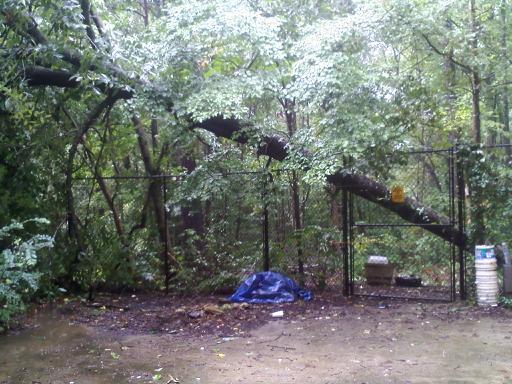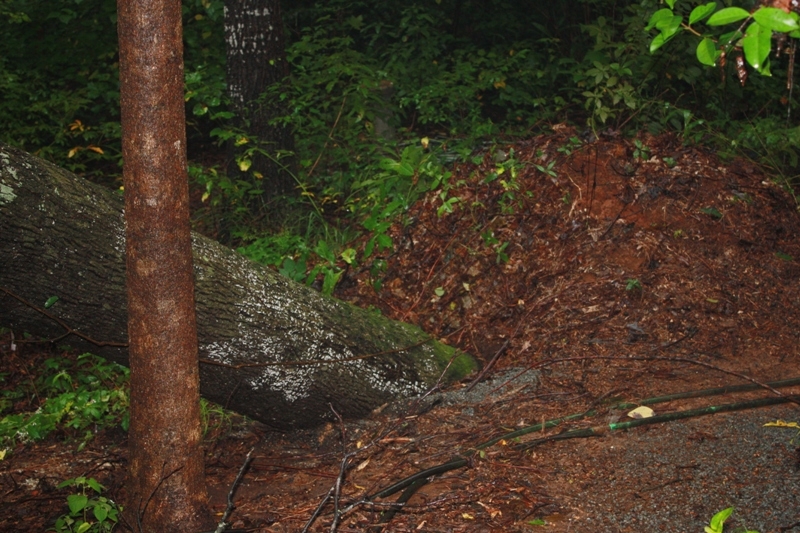Ask An Arborist: October 1, 2009
 |
 |
|
Toppled Hickory After Heavy Rain |
Water-logged Soil
|
Personal Story
The heavy rains of two weeks ago brought tree problems to the Schrum household. An absolutely gorgeous 80-foot hickory just 15 feet
off the back of my house suddenly toppled over without wind or warning. My daughter said that the tree simply started to
shake violently and then just went over. It's fall was broken about half way down when it landed against a nearby 60-foot
tulip poplar. With the wet soil, the tulip poplar was only able to hold the fallen hickory and itself upright for about
six hours until it also toppled over. Why did this happen?
And The Answer Is...
To put it simply, the hickory became top heavy as the tree's root system could no longer support the upper weight of the
tree when the soil became so heavily saturated. This could be labeled the perfect "trifecta:" the soil lost strength as
water filled and expanded the microscopic gaps between the soil particles, the smaller and medium roots were more easily
pulled free from the saturated soil and finally, the major roots closest to the trunk had probably suffered damage due to years of
severe drought. Even though the tree was fully leafed out and appeared healthy, forces were at work below the soil that
simply proved to be too much. The tulip poplar which was a younger tree and was further away from structures that may have
impacted its root system, simply was an innocent bystander.
Fortunately, this hickory has been littering my woods with
nuts for years and I have many seedlings of various ages to replace it. As with many woodland landscapes, I have a gazillion
tulip poplars.
Technically Speaking...
We posed this question to Dr. Larry Morris, Professor of Forest Resources at UGA. His response is as follows:
"Several of our readers have asked why so many trees fall during floods even when winds are not particularly strong. To answer
this, letís first look at how a tree is anchored. Three factors play an important role in tree resistance to falling: soil shear
strength, fine and lateral root tensile strength and root plate integrity. The first factor, the shear strength of soil, can be
visualized as the resistance of two blocks of soil from slipping past one another. Shear strength is important in resisting the
rotational movement of soil involved in tree fall and in resisting roots pulling free from the soil. The second factor is root
tensile strength. As the wind begins to force a tree over, the force is transferred to the roots which behave like many fine
ropes transferring the force out into the soil. The strength of these roots help determine the amount of force that can be
resisted. The third factor is the root plate. The root plate is the area of large rigid roots that extend out from the trunk.
The root plate is important in resisting tree fall both by the weight and mass it adds to the tree but also by providing a rigid
pivot over which the tree must be pulled before it can fall.
Trees fall during flooding because the same saturated soil conditions that create the excessive runoff that produces floods
also reduces soil strength. Under dry soil conditions, soil shear strength is high because individual soil particles are pulled
close together. As soil wets, the water films between particles expand and there is less resistance. When soils are saturated,
shear strength of soil is very low and soil capacity to resist tree fall is also low.
The low shear strength of soil under saturated conditions can be compounded by several common problems in urban environments.
Many urban soils have been heavily graded and compacted at depth. Although the surface soil may have excellent rooting conditions,
the compacted layer creates an interface at depth in the soil. This interface limits both root growth and water flow into deeper
soils. When heavy rains saturate the soil above the interface, even a modest wind force can cause the tree to topple.
Many urban trees also have root systems that are poorly structured due to conflicts with hardscape. When roots systems
cannot grow laterally out into the soil, they have limited ability to resistance wind. Finally, root disease can reduce both
root tensile strength and the integrity of the root plate. The combination of compromised root system health and saturated
soils creates just the right conditions for trees to fall.
Possible Solutions
Although it is not possible to stop the rains that create saturated soils, you can help protect your trees from falling by
proper soil and root care. Prior to planting any new area, deep compaction should be corrected. Excavation or construction
that cuts roots should be avoided. Fills should be minimized in extent and depth as they can kill roots. Root collars should be
excavated and any girdling roots that limit development of the root plate eliminated. Finally, pruning that properly distributes
and minimizes wind resistance should be completed."
Dr. Kim Coder of UGA has published a wonderful article with diagrams entitled
"Plant Trees Right"
which will show you the proper way to plant trees.
If you are concerned about the trees in your landscape, you can contact a Certified Arborist or a professional tree company in
your area through the web site of the
Georgia Arborist Association.
If you have comments or questions about this article or want to submit a question that may be used in a future article, please
email me.
Images & Drawings Copyrighted © 2009 by Theresa Schrum - All rights reserved



